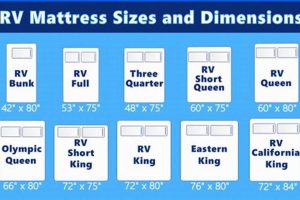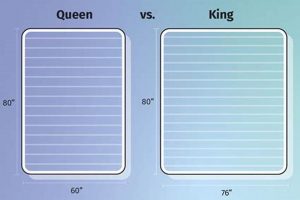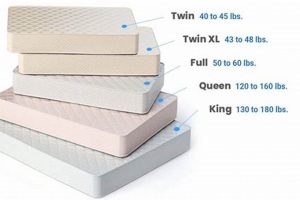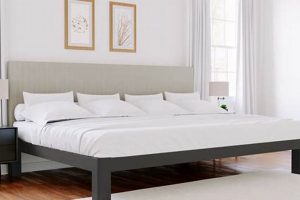A large sleeping surface, typically 76 inches wide and 80 inches long, provides ample space for individuals or couples who prefer a greater range of movement during sleep. The accompanying foundation offers support and elevation, contributing to the overall longevity and comfort of the sleep system. This combination represents a significant investment in sleep health and bedroom furniture.
The generous dimensions accommodate diverse sleeping styles and reduce partner disturbance. Historically, larger beds signified status and comfort, evolving from basic straw mattresses to sophisticated innerspring and foam constructions resting upon sturdy foundations. The benefits extend to improved sleep quality and a more luxurious rest experience.
The following sections will detail factors to consider when selecting the proper large bed setup, including material options, support systems, and considerations for room size and budget. Specific focus will be given to the impact of each component on sleep quality and overall well-being.
Guidance for Selecting a King Size Mattress with Boxspring
The selection of a suitable large sleeping surface and its corresponding foundation requires careful consideration. Several factors influence the optimal choice, directly impacting sleep quality and overall satisfaction.
Tip 1: Assess Spatial Constraints: Prior to purchase, measure the intended bedroom space to ensure adequate clearance. A disproportionately large bed can impede movement and diminish the room’s functionality.
Tip 2: Determine Firmness Preference: Different materials and construction methods offer varying levels of support. Consider individual sleep position and weight distribution when selecting firmness. A side sleeper may benefit from a softer surface, while a back or stomach sleeper may prefer a firmer one.
Tip 3: Evaluate Foundation Compatibility: Ensure the selected foundation is designed to support the specific mattress type. An incompatible foundation can compromise the mattress’s structural integrity and void warranties.
Tip 4: Consider Material Composition: Options include innerspring, memory foam, latex, and hybrid constructions. Each material offers distinct advantages regarding breathability, motion isolation, and pressure relief. Research the properties of each material before making a decision.
Tip 5: Review Warranty Information: Carefully examine the manufacturer’s warranty to understand the terms and conditions. A comprehensive warranty protects against manufacturing defects and premature wear.
Tip 6: Inquire About Trial Periods: Many retailers offer trial periods, allowing consumers to test the bed in their own homes. Take advantage of this opportunity to assess comfort and support over an extended period.
Tip 7: Research Box Spring Alternatives: Box springs are one option, but platform beds or adjustable bases can provide enhanced support and functionality. Consider all options before committing to a traditional box spring.
By carefully evaluating these factors, individuals can make an informed decision, leading to a more comfortable and restful sleep experience. Proper selection ensures optimal support, longevity, and overall value.
The following sections will explore the maintenance and care procedures necessary to prolong the lifespan of the chosen sleep system.
1. Dimensions and Space
The relationship between the physical dimensions of a large sleeping surface and the available space within a bedroom is paramount to both functionality and aesthetic balance. Careful consideration of these factors prevents overcrowding and ensures comfortable navigation within the room.
- Room Size Minimums
A room intended for a large sleeping surface should ideally be at least 12 feet by 12 feet. This allows for adequate space around the bed, facilitating movement and accommodating additional furniture. Smaller rooms may necessitate strategic furniture placement to avoid a cramped environment. Consider the presence of dressers, nightstands, and walking paths when assessing spatial feasibility.
- Doorway and Stairwell Clearance
Before purchasing, measure doorways and stairwells to confirm the mattress and boxspring can be maneuvered into the room. The dimensions of a large mattress can present challenges during delivery and installation. Disassembly or alternative delivery methods may be necessary for rooms with limited access.
- Furniture Placement Considerations
The dimensions of the sleeping surface directly impact the placement of other furniture within the room. Nightstands, dressers, and seating areas must be positioned to maintain comfortable pathways and avoid obstructing doors or windows. Scale drawings or digital room planners can assist in visualizing furniture arrangements prior to purchase.
- Impact on Perceived Room Size
A disproportionately large sleeping surface can visually overwhelm a smaller room, making it appear even smaller. Lighter colors and minimalist design principles can mitigate this effect, creating a more open and airy atmosphere. Conversely, a properly sized sleeping surface enhances the room’s perceived size and contributes to a sense of spaciousness.
In summary, the effective integration of a large sleeping surface within a bedroom requires meticulous planning and attention to detail. By carefully assessing room dimensions, access routes, and furniture placement, individuals can optimize both the functionality and aesthetic appeal of their sleep environment. Failure to account for these factors can result in a cramped and uncomfortable living space.
2. Material Composition
The constituent materials of a large bed and its foundation significantly influence sleep quality, durability, and overall cost. Understanding the properties of each material is crucial for making an informed purchase decision.
- Mattress Core Materials: Innerspring Coils
Innerspring systems, a traditional option, provide support through interconnected or individually wrapped coils. Coil count and gauge (thickness) determine firmness and support level. Higher coil counts and lower gauge numbers generally indicate greater support and durability. However, innerspring mattresses may exhibit greater motion transfer compared to other types.
- Mattress Core Materials: Memory Foam
Memory foam conforms to the body’s contours, providing pressure relief and motion isolation. Density, measured in pounds per cubic foot (PCF), indicates the foam’s quality and longevity. Higher density foams are more durable and resistant to body impressions. However, memory foam can retain heat, potentially leading to discomfort for some sleepers
. Gel-infused or open-cell memory foam options mitigate this issue. - Mattress Core Materials: Latex
Latex, derived from rubber trees, offers a responsive and durable sleeping surface. Natural latex is more breathable and hypoallergenic compared to synthetic latex. Dunlop and Talalay are two processing methods that yield different densities and firmness levels. Latex offers a balance of support and comfort, with excellent motion isolation and temperature regulation properties.
- Boxspring Materials: Wood and Steel
The foundation, traditionally a boxspring, provides support and elevation for the mattress. Wooden frames should be constructed from solid hardwoods for optimal durability. Steel supports, either in the form of coils or metal grids, contribute to the foundation’s weight-bearing capacity. A well-constructed foundation prevents sagging and extends the lifespan of the mattress.
The selection of materials should align with individual sleep preferences, budget considerations, and long-term durability expectations. Hybrid mattresses, combining innerspring coils with layers of memory foam or latex, offer a potential compromise between the benefits of each material type. Ultimately, a comprehensive understanding of material properties is essential for maximizing sleep quality and the return on investment in a large sleeping surface.
3. Support System
The structural integrity of a large bed system hinges significantly on its support system. This encompasses both the internal components of the mattress itself and the foundation upon which it rests. The interplay between these elements directly influences spinal alignment, pressure distribution, and overall sleep quality.
- Innerspring Coil Configuration
Coil systems within a mattress offer varying degrees of support depending on their configuration. Bonnell coils, an older design, provide uniform support but can exhibit motion transfer. Pocketed coils, individually wrapped, minimize motion disturbance and conform more closely to the body’s contours. The gauge and density of the coils also contribute to the firmness and durability of the mattress. For example, a higher gauge coil will provide a firmer feel. In large beds, the coil system must adequately support the increased surface area to prevent sagging.
- Foam Density and Layering
Foam mattresses, particularly those constructed from memory foam or latex, rely on density and layering to provide support. High-density foams offer greater resistance and prevent excessive sinking. Strategic layering of different foam types can create zones of varying firmness to accommodate different body regions. A well-designed foam support system ensures proper spinal alignment, crucial for preventing back pain and promoting restful sleep. The foam layers must be sufficient to support the weight distribution across a large surface area.
- Foundation Types: Box Springs vs. Platform Beds
The foundation provides a stable base for the mattress. Traditional box springs consist of a wooden or metal frame with internal springs, offering some degree of shock absorption. Platform beds, in contrast, provide a solid, unyielding surface. The choice between these options depends on mattress type and desired level of support. Some manufacturers specify particular foundation types to maintain warranty coverage. Using an improper foundation, such as placing a memory foam mattress designed for a platform bed on a traditional box spring, can reduce its lifespan and void the warranty.
- Edge Support Systems
Edge support refers to the reinforcement along the perimeter of the mattress. This prevents edge sagging and provides a stable surface for sitting or sleeping near the edge. Edge support systems can consist of reinforced coils, high-density foam rails, or a combination of both. Adequate edge support is especially important in large sleeping surfaces to maximize usable sleeping area and prevent roll-off. Without adequate edge support, the perimeter of the bed can compress, reducing the overall comfort and lifespan of the mattress.
The support system is not merely a collection of individual components; it is an integrated network that must function cohesively to provide optimal sleep. Selecting a large mattress without considering the underlying support structure is a false economy, potentially leading to premature wear, discomfort, and compromised sleep quality. The interaction between mattress type and foundation is especially crucial, with manufacturers often providing specific recommendations to ensure proper support and longevity.
4. Foundation Strength
The structural integrity of the foundation supporting a large sleeping surface is paramount to its longevity and performance. The foundation’s ability to withstand distributed weight over time directly impacts the mattress’s support characteristics and resistance to sagging. An inadequate foundation can negate the benefits of even the highest-quality mattress.
- Weight Distribution Capacity
A foundation must possess sufficient weight-bearing capacity to accommodate the mattress and occupants without deformation. For a large bed, this requirement is magnified due to the increased surface area and potential for concentrated weight loads. Exceeding the foundation’s weight limit can result in structural failure, compromising the mattress’s support and creating uneven sleeping surfaces. Foundation materials and construction techniques directly influence weight distribution capabilities. Steel supports, reinforced wooden frames, and closely spaced slats contribute to increased weight capacity.
- Material Durability and Longevity
The materials used in foundation construction dictate its long-term durability. Solid hardwoods, high-gauge steel, and reinforced joints enhance the foundation’s resistance to wear and tear. Lower-quality materials may degrade over time, leading to squeaking, sagging, or outright collapse. Regular inspection of the foundation for signs of damage, such as cracks, loose joints, or warped supports, is essential for maintaining its structural integrity. Proper maintenance can significantly extend the foundation’s lifespan and preserve the mattress’s performance.
- Support Uniformity and Sag Prevention
A foundation must provide consistent support across the entire mattress surface to prevent sagging. Uneven support can lead to pressure points, spinal misalignment, and reduced sleep quality. Slatted foundations should feature closely spaced, robust slats to distribute weight evenly. Box springs, while offering some cushioning, can be prone to sagging over time, particularly in the center. Platform beds, with their solid or closely spaced slatted surfaces, generally provide superior support uniformity. Selecting a foundation designed to resist sagging is crucial for maintaining the mattress’s intended support characteristics.
- Compatibility with Mattress Type
The type of foundation must be compatible with the specific mattress being used. Innerspring mattresses typically perform well with traditional box springs or slatted foundations. Memory foam and latex mattresses, however, often require solid or closely spaced slatted foundations to prevent deformation and maintain thei
r support characteristics. Using an incompatible foundation can void the mattress warranty and significantly reduce its lifespan. Manufacturers often specify recommended foundation types to ensure optimal performance and longevity.
The foundation is not a mere afterthought in the sleep system; it is a critical component that directly influences the mattress’s performance and lifespan. Choosing a foundation with adequate strength, durability, and compatibility is essential for maximizing the investment in a high-quality large bed and ensuring years of comfortable and supportive sleep. Neglecting foundation strength can lead to premature mattress wear, compromised sleep quality, and ultimately, increased replacement costs.
5. Durability
The long-term functionality of a large sleeping surface and its associated foundation is directly tied to the durability of their constituent materials and construction. Durability represents a critical factor in the overall value proposition, influencing the lifespan of the investment and the sustained quality of sleep experienced.
- Material Fatigue and Degradation
The continuous application of weight and pressure leads to material fatigue within the mattress and foundation. Foam components may compress over time, reducing their supportiveness. Springs can lose their tension, resulting in sagging. Wood frames may warp or crack under stress. The selection of high-quality materials, such as high-density foams, tempered steel coils, and solid hardwoods, mitigates the effects of material fatigue. Regular rotation of the mattress can also distribute wear more evenly, prolonging its lifespan. Material degradation directly impacts the ability of the sleeping surface to provide adequate support and maintain its original comfort level.
- Construction Integrity and Joint Stability
The manner in which the mattress and foundation are assembled significantly impacts their long-term stability. Weak joints or poorly secured components are susceptible to failure under repeated stress. Reinforced seams, robust fasteners, and solid construction techniques enhance the overall integrity of the sleep system. In the case of foundations, securely attached legs or a well-supported frame are essential for preventing collapse. Construction flaws can lead to squeaking, wobbling, and ultimately, a compromised sleeping surface.
- Resistance to Environmental Factors
The surrounding environment can influence the durability of a bed. Exposure to humidity, temperature fluctuations, and pests can accelerate material degradation. Moisture can promote mold growth within foam layers, while excessive dryness can cause wood to crack. Protective mattress covers and regular cleaning can minimize the impact of environmental factors. Proper storage conditions, such as avoiding direct sunlight and maintaining adequate ventilation, are essential for preserving the integrity of the materials. Selecting materials resistant to environmental damage, such as naturally antimicrobial latex, can further enhance durability.
- Warranty Coverage and Expected Lifespan
The manufacturer’s warranty provides an indication of the expected lifespan and the level of confidence in the product’s durability. A longer warranty typically reflects a greater commitment to quality and a lower likelihood of premature failure. However, warranty terms and conditions should be carefully scrutinized to understand the extent of coverage. The warranty is not a guarantee of indefinite durability, but rather a safeguard against manufacturing defects and premature wear under normal use conditions. The actual lifespan of a large bed depends on a combination of material quality, construction techniques, usage patterns, and environmental factors.
Durability is not solely a function of initial cost. While higher-priced models may incorporate more durable materials and construction, proper maintenance and usage habits play a significant role in extending the lifespan of any large bed. Investing in a durable sleep system represents a long-term commitment to sleep quality and overall well-being, minimizing the need for frequent replacements and maximizing the return on investment.
6. Budget
The financial allocation, or budget, represents a primary determinant in selecting a large-format sleeping surface and its corresponding foundation. This constraint necessitates a careful evaluation of available options, balancing desired features with affordability.
- Entry-Level Options and Material Compromises
At the lower end of the price spectrum, offerings often incorporate less expensive materials and simplified construction techniques. For example, entry-level mattresses may utilize lower-density foams or thinner gauge coils, potentially impacting long-term durability and support. Foundations may feature less robust framing or utilize composite wood rather than solid hardwood. These compromises allow for a lower initial investment but may result in reduced lifespan and performance.
- Mid-Range Considerations and Feature Balancing
The mid-range budget allows for a greater selection of materials and construction methods. Mattresses in this category may feature a combination of innerspring and foam layers, providing a balance of support and comfort. Foundations may incorporate reinforced steel supports and higher-quality wood framing. The mid-range requires a careful evaluation of features, balancing desired comfort characteristics with long-term durability. Prioritizing specific features, such as enhanced edge support or advanced cooling technologies, may require trade-offs in other areas.
- Premium Investments and Material Excellence
Higher-end budgets enable access to premium materials and construction techniques. Mattresses may feature natural latex, high-density memory foam, or individually pocketed coils for superior comfort and support. Foundations may incorporate solid hardwood framing, reinforced steel supports, and meticulously crafted joints. These materials offer enhanced durability, longevity, and performance, justifying the higher initial investment. Premium options often incorporate advanced features, such as adjustable bases and integrated temperature regulation systems.
- Long-Term Cost Implications and Value Assessment
While a lower initial price point may seem attractive, the long-term cost implications should be carefully considered. Less durable options may require more frequent replacement, ultimately exceeding the cost of a more durable, albeit more expensive, alternative. A value assessment should incorporate factors such as expected lifespan, warranty coverage, and the potential for improved sleep quality. Investing in a higher-quality large bed and foundation may result in a lower total cost of ownership over the long term, while also providing a more comfortable and supportive sleep experience.
Budgetary constraints dictate the range of available choices; however, a thorough understanding of material properties, construction techniques, and long-term cost implications enables informed decision-making. Selecting a large sleeping surface and foundation that aligns with both financial limitations and desired performance characteristics ensures optimal value and a restful sleep environment.
7. Warranty
The warranty associated with a large sleeping surface and foundation serves as a critical indicator of manufacturer confidence and consumer protection against defects and premature wear. Understanding the scope and limitations of this coverage is essential before committing to a purchase.
- Coverage Duration and Scope
The duration of the warranty, often ranging from one to twenty-five years, reflects the manufacturer’s assessment of the product’s expected lifespan. The scope defines the specific types of defects covered, typically encompassing manufacturing flaws, sagging exceeding a specified threshold, or structural failures. Damage resulting from misuse, improper support, or stains is generally excluded. The warranty’s duration and scope directly influence the consumer’s recourse in the event of product failure.
- Pro-Rated vs. Non-Pro-Rated Coverage
Pro-rated warranties stipulate that the consumer bears an increasing portion of the repair or replacement cost as the product ages. Non-pro-rated warranties cover the full cost of repair or replacement within the covered period. The type of warranty significantly impacts the financial burden associated with addressing covered defects. For instance, a pro-rated warranty on a ten-year mattress may only cover a small fraction of the replacement cost in the later years of the coverage period.
- Specific Exclusion Clauses and Limitations
Warranty agreements contain specific exclusion clauses that delineate circumstances under which coverage is voided. These exclusions may include the use of an improper foundation, evidence of physical damage, unsanitary conditions, or commercial use. Carefully reviewing these exclusions is crucial to understanding the warranty’s limitations and avoiding potential claim denials. Failure to adhere to the manufacturer’s recommendations regarding foundation type or mattress care can invalidate the warranty.
- Claim Procedures and Documentation Requirements
The process for filing a warranty claim typically involves providing proof of purchase, photographs of the defect, and a detailed description of the issue. Manufacturers may require inspection of the mattress and foundation by an authorized representative. Adhering to the specified claim procedures and providing all required documentation is essential for a successful claim resolution. Failure to follow these procedures can result in delays or denial of coverage.
The warranty associated with a large bed and foundation is not merely a marketing tool; it represents a legally binding agreement that outlines the manufacturer’s obligations and the consumer’s rights. A thorough understanding of the warranty’s terms and conditions, including coverage duration, scope, exclusions, and claim procedures, is crucial for making an informed purchase decision and protecting the investment in a comfortable and supportive sleep environment. Moreover, proper documentation and adherence to manufacturer guidelines are crucial for navigating any potential warranty claim process effectively.
Frequently Asked Questions
This section addresses common inquiries regarding the selection, care, and longevity of a large sleeping surface and its associated foundation. The information presented aims to provide clarity and guidance for informed decision-making.
Question 1: What are the minimum room dimensions recommended for a king size mattress with boxspring?
A room measuring at least 12 feet by 12 feet is generally recommended to accommodate the dimensions of this setup. This allows for adequate space around the bed for movement and additional furniture.
Question 2: How often should a king size mattress be rotated?
Rotating the mattress every six months is advisable to promote even wear and prolong its lifespan. This practice helps distribute weight and prevent impressions from forming in specific areas.
Question 3: What type of foundation is best suited for a memory foam king size mattress?
Solid platform foundations or closely-slatted foundations are generally recommended for memory foam mattresses. These foundations provide consistent support and prevent sagging, which can occur with traditional box springs.
Question 4: How can the lifespan of a box spring be extended?
Ensuring the box spring is placed on a level surface and avoiding excessive weight or impact can extend its lifespan. Regular inspection for damage and prompt repairs are also recommended.
Question 5: What is the typical weight capacity of a king size mattress with boxspring?
The weight capacity varies depending on the construction and materials used. However, most are designed to support at least 500-600 pounds. Consult the manufacturer’s specifications for precise weight limits.
Question 6: Are there any specific cleaning recommendations for a king size mattress?
Vacuuming the mattress regularly is recommended to remove dust and allergens. Spot cleaning with a mild detergent solution can address stains. A mattress protector can also help prevent stains and prolong the mattress’s lifespan.
The insights provided offer a foundational understanding of key considerations regarding the maintenance and effective utilization of this sleep system.
The subsequent section delves into common misconceptions surrounding large-format sleep systems, further enhancing comprehension.
Conclusion
The preceding discussion has explored multifaceted considerations surrounding the selection, maintenance, and long-term performance of the king size mattress with boxspring. Key aspects such as dimensional requirements, material properties, support systems, foundation strength, durability, budgetary constraints, and warranty provisions were examined in detail. These factors collectively influence the overall value and suitability of the system for individual sleep needs.
Optimal sleep health relies on informed choices. Individuals must weigh objective criteria against personal preferences to achieve a restful and supportive sleep environment. The king size mattress with boxspring, while offering ample space and potential for enhanced comfort, necessitates careful planning and diligent consideration to maximize its benefits and ensure a lasting investment in well-being.




![Best Soft King Mattress [Guide] For Restful Sleep Organic & Natural Mattress Buyer’s Guide: Non-Toxic Sleep Solutions Best Soft King Mattress [Guide] For Restful Sleep | Organic & Natural Mattress Buyer’s Guide: Non-Toxic Sleep Solutions](https://mattressworldpa.com/wp-content/uploads/2025/07/th-8174-300x200.jpg)


